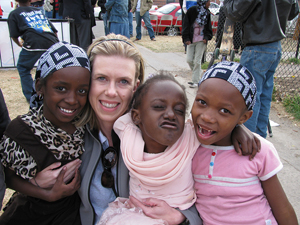In this era of post-recession cost cutting, many construction companies remain committed to the communities where they live and work. Instead of pulling back on their charitable funding, firms have amped up community-service programs and refocused their giving strategies to maximize dollars.


The construction industry appears to be in sync with general trends in corporate giving. A study released in December 2011 by Forbes Insights and Hewlett Packard found that involvement in corporate volunteerism has become more important in recent years than before the recession, with the majority of companies looking to make financial donations primarily to causes that will allow their employees to volunteer.
The study also notes that motivations for corporate philanthropy are not entirely altruistic. Allowing employees to follow their passions and support causes they care about helps increase employee loyalty and keeps people motivated during times when salary bumps are scarce. The study says volunteering enriches creativity in product and market development, and skill-based philanthropic efforts showcase the company’s talents and help attract new business. In construction, such projects might include building low-income housing, rehabbing homeless shelters or constructing playgrounds for area schools.
“While the industry’s outlook toward philanthropy has changed in recent years, its commitment to giving and community service has not wavered,” says Melinda Patrician, director of the AGC Education & Research Foundation for the Associated General Contractors of America. “Whereas companies had been giving more generally to causes, they now are targeting their funds toward specific needs. They want to see the impact their money is going to have, and they are especially interested in things that will leave a legacy and grow the industry.”
Since 1970, the AGC Education & Research Foundation has awarded more than 3,000 scholarships totaling more than $8 million. After seeing a decline in contributions at the onset of the recession, the foundation is experiencing an upturn now. “Our story is fairly typical of most nonprofits around the country. People were cautious and rightfully so, but they’re now feeling more confident,” Patrician adds.
In 2008, at a time when many companies were reducing costs, AGC stepped up its efforts and established AGC Charities Inc. to focus on philanthropic activities. Among other initiatives, the organization runs Operation Opening Doors—a national program where companies donate their time, money and expertise to remodel homes or facilities for injured veterans and other people with disabilities. 2012 marked the first year where AGC Charities was able successfully to undertake two Operation Opening Doors (OOD) projects—one in March 2012 in conjunction with AGC’s 94th Annual Convention in Honolulu, Hawaii, and another at an American Legion Post in Washington, D.C.
Contractor Programs
Clark Construction Group, Bethesda, Md., maintains an in-house charitable foundation that donates roughly $4 million annually, and despite the economic downturn, that amount has remained relatively consistent in recent years, says Susan Williamson Ross, the company’s executive vice president and chief administrative officer. “We made a conscious decision that we were not going to cut back on our community service or charitable giving,” Ross says. “There is more need now than before the recession. What we have done is take a more targeted approach. Instead of lots of smaller gifts spread across many projects, we give larger gifts to a more focused group of projects, so our giving will have more impact,” she adds.
Clark focuses the majority of its giving and community service in the Washington, D.C. area, with a special focus on projects for wounded, active-duty service members and veterans from nearby military hospitals, including the new Walter Reed National Military Medical Center, a joint venture of Clark/Balfour Beatty. One such cause is TeamRiverRunner, a volunteer-based nonprofit that empowers wounded soldiers, many who have lost limbs, with new physical challenges through whitewater kayaking and other paddle sports. Clark also pledged $500,000 toward construction of the nonprofit Boulder Crest Retreat in Virginia, a 37-acre facility with accommodations and recreational therapeutic services to help wounded warriors and their families relax and reconnect.
At New York-based Turner Construction, giving has remained relatively consistent, according to Alison Stanton, the company’s community affairs director for the Boston area. “We’ve had to revisit the way we do things to be more efficient and ensure that our efforts have the greatest impact possible, but we have not made any cutbacks,” Stanton says.
In recent years, the company increased in-kind donations of employee time and labor, she adds. Turner—a recipient of the AGC in the Community Award for the last two years—operates national mentoring and training programs implemented at the local level by community involvement teams within each of its offices.
“Community involvement decisions are made at the local level because our employees work and live in these communities and better understand what projects are most meaningful. Every business unit sets aside a portion of their annual budget to fund community projects,” Stanton says.
In 2009, Saunders Construction, Centennial, Colo., expanded its philanthropic efforts beyond traditional donations and launched a new program called Building Confidence in Kids. “It was a time when people weren’t giving as much. That’s when we saw the need to do more,” says Marcy Loughran, marketing and communications director at Saunders.
The company commits 10% of its profits to the program and other community giving, and despite leaner times for the industry, exceeded that goal in 2011 and 2012. Building Confidence in Kids partners with a local nonprofit selected by a 10-person committee comprised of Saunders staff members. No company executives can serve on the committee—a crucial component—as this allows employees to act independently and take ownership of the program, Loughran says.


Post a comment to this article
Report Abusive Comment